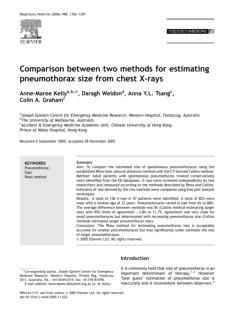Scientific papers 2005










Optimization of oxygen tolerance extension by
intermittent exposure was studied in groups of 20 rats
exposed to systematically varied patterns of alternating
oxygen and normoxic breathing periods at 4.0, 2.0, and
1.5 ATA. Oxygen periods of 20, 60, and 120 min were
alternated with normoxic intervals that provided oxygen-
to-normoxia ratios of 4:1, 2:1, 1:1, and 1:3.
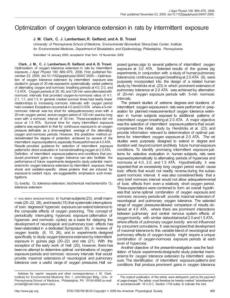

This paper gives a detailed history of the deep-diving
operations and researches undertaken by COMEX.
These operations and studies resulted in the creation of
tables such as those used by the French ministry of labour
and also the NORMAM 15/DPC procedures in Brazil.
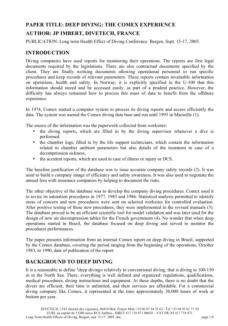

Authors:
Z. Dujic, I. Palada, A. Obad, D. Duplancic, D. Bakovic, & Z.
Valic.
Decompression sickness is initiated by the formation of
gas bubbles in tissue and blood if the divers return to
surface pressure too fast. The effect of exercise before,
during, and after dive on bubble formation is still
controversial. The team reported previously that strenuous
aerobic exercise 24 h before simulated dive ameliorates
venous bubble formation. The objective of this field study
was to evaluate whether mild, continuous exercise during
decompression has a similar impact.
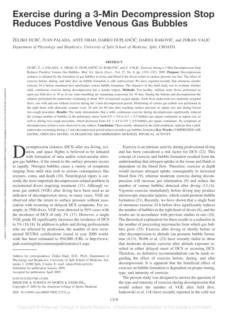

Authors:
Jean-Eric Blatteau, Emmanuel Gempp, Franc¸ois-Michel
Galland, Jean-Michel Pontier, Jean-Marie Sainty, and
Claude Robinet.
A single bout of aerobic exercise 24 h before a dive
significantly reduces the formation of circulating venous
gas emboli (VGE) on decompression. The purpose of this
investigation was to determine the effect of aerobic
exercise 2 h before a dive.
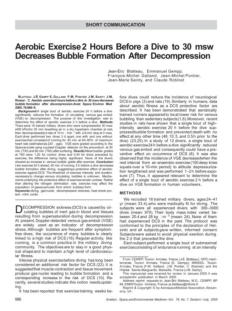

Sixteen U.S. Navy divers began a series of 4-hour dives at
a PO2 of 1.4 atm daily for two consecutive five-day weeks.
Nine divers were able to finish; all withdrawals were for
nonpulmonary reasons. Divers rested on the bottom of a
15-foot freshwater pool and breathe humidified 100%
oxygen open circuit from MK 20 full face masks. Flow-
volume curves and diffusing capacity were measured at
baseline, daily during diving, and after the series.
Symptoms and changes in pulmonary function values
were used to measure pulmonary oxygen toxicity, and
the results were compared to earlier series of similar four-
hour dives.
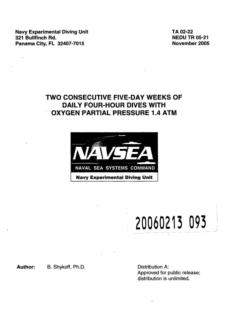

Authors: David M. Dromsky, Bruce D. Spiess, Andreas
Fahlman.
The authors of this paper examined an adjunctive
treatment for severe decompression sickness (DCS) to be
used when hyperbaric treatment is delayed or
unavailable. It is based on the hypothesis that intravenous
perfluorocarbon (PFC) emulsion combined with 100%
inspired O2 would improve severe DCS outcomes.
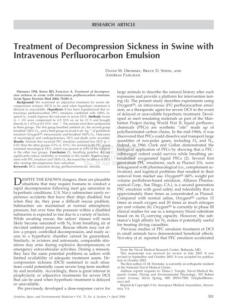

Authors: A. O. Brubakk, D. Duplancic, Z. Valic, I. Palada,
A. Obad, D. Bakovic, U. Wisloff, and Z. Dujic.
During and after decompression from dives, gas bubbles
are regularly observed in the right ventricular outflow
tract. Several studies have documented that these bubbles
can lead to endothelial dysfunction in the pulmonary
artery, but no data exist on the effect of diving on arterial
endothelial function. The present study investigated if
diving or oxygen breathing would influence endothelial
arterial function in man.
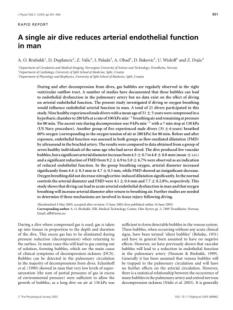

Author: Page R Painter
The maximum metabolic rate (MMR) of mammals is
approximately proportional to M0.9, where M is the
mammal's body weight. Therefore, MMR increases with
body weight faster than the basal metabolic rate (BMR),
which is approximately proportional to M0.7. MMR is
strongly associated with the capacity of the cardiovascular
system to deliver blood to capillaries in the systemic
circulation, but the properties of this vascular system have
not produced an explanation for the scaling of MMR.


Author: R. Kłos
Research on the validation of decompression tables is one
of the common subject areas of the cooperation
undertaken between the DRDC Toronto, Canada, and
The Naval University of Gdynia, Poland.
A survey of diving technologies has been conducted for
Scientific Research and the Polish Navy. Among the most
critical problems discussed have been various aspects of
decompression safety. The following is a study to
standardize and unify validation procedures for
decompression in the Polish Navy.
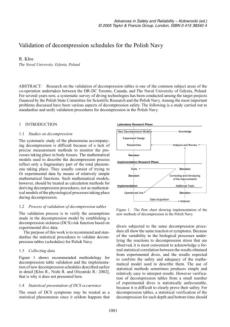

Author: John B. West
In 1660, Robert Boyle (1627–1691) published his
landmark book New Experiments Physico-Mechanicall,
Touching the Spring of the Air, and its Effects in which he
described the first controlled experiments of the effects of
reducing the pressure of the air. Critical to this work was
the development of an air pump by Boyle with Robert
Hooke (1635–1703). For the first time, it was possible to
observe physical and physiological processes at both
normal and reduced barometric pressures.
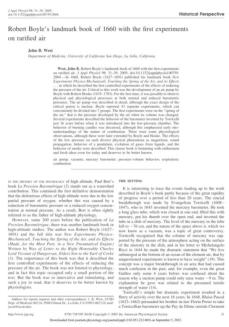

Authors:
Richard A. Neubauer, Virginia Neubauer, & Franz
Gerstenbrand
Controlled studies have demonstrated safety and efficacy
of hyperbaric oxygenation therapy (HBOT) in the
treatment of anoxic, traumatic, ischemic, or thrombotic
brain injury.
Clinical improvements were correlated with increased
perfusion and metabolism, with reactivation of idling
neurons demonstrated by sequential single photon
emission computerized tomographic (SPECT) scanning.
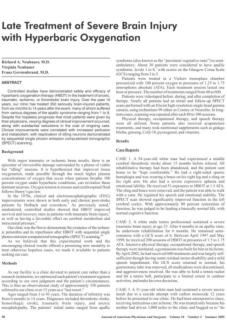

Authors: T. Stensrud, S. Berntsen, K.-H. Carlsen
Exercise-induced bronchoconstriction (EIB) increases in
cold and dry air and decreases in humid air in subjects
with asthma. Few reports have reported on the effect of
humid environment upon exercise capacity in subjects
with EIB.
The primary aim of the present study was to examine the
effect of changing the humidity of the environmental air
upon exercise capacity measured by peak oxygen uptake,
peak ventilation and peak running speed and secondarily
to assess the influence of environmental humidity upon
EIB in subjects suffering from EIB.
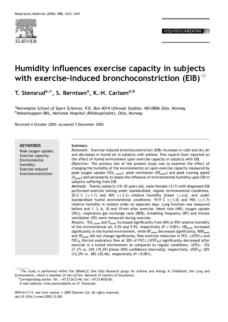

Author: R.W. Hamilton
This paper attempts to show how a variety of
decompression tables, including some that are not “in the
book,” can lead to improved decompression capability.
Such tables are often available from diving training
organizations. They can also be obtained from
decompression specialists, and in some cases, can be
developed by the using organization. Many innovative
table collections are available from specific sources.
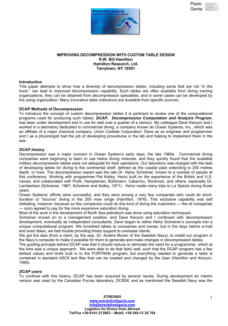

Authors: Manfred R. Enstipp, David Grémillet, and Svein-
Håkon Lorentsen
This paper attempts to show how a variety of
decompression tables, including some that are not “in the
book,” can lead to improved decompression capability.
Such tables are often available from diving training
organizations. They can be obtained from decompression
specialists, and in some cases, can be developed by the
using organization. Many innovative table collections are
available from specific sources.
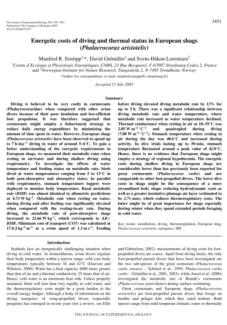

Click on the octopus
to return to the top
of the page

Authors: James T. Webb, Andrew A. Pilmanis, ULF I.
Balldin, Joseph R. Fisher
The US Air Force studied altitude decompression sickness
(DCS) using a database with data from 2980 exposures.
The study involved 240 subjects and found DCS incidence
rates ranging from 5 to 95%. Researchers assessed
susceptibility by examining factors such as height, weight,
age, body fat percentage, and aerobic capacity. Findings
showed that DCS incidence was 46.5% during 1,879
subject exposures. A correlation was found between
lower aerobic capacity and greater weight, higher
susceptibility to DCS, these factors only explain less than
13% of the variation in risk.
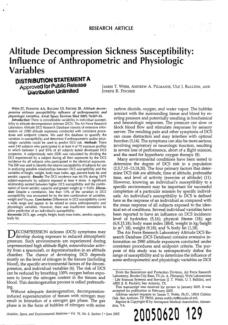

Authors: W Padilla, H B Newton, S Barbosa
This article documents the first case of Weber's syndrome
due to decompression illness in a 55-year-old recreational
scuba diver with a history of a pulmonary cyst. Weber's
syndrome involves oculomotor nerve palsy and
contralateral hemiparesis. Symptoms appeared after a
deep dive exceeding no-decompression limits. The injury
mechanism may involve air gas embolism and
decompression sickness, with pre-existing pulmonary cysts
potentially increasing the risk of complications.
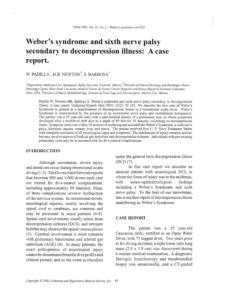

Authors: Earl S. Ford, Harold W. Kohl, Ali H. Mokdad, &
Umed A. Ajani
This study analyzed 1,626 adults to examine the link
between physical activity, sedentary behavior, and
metabolic syndrome. Results indicated that those not
engaging in moderate or vigorous physical activity had
nearly double the odds of metabolic syndrome compared
to those with at least 150 minutes of such activity weekly.
The study concludes that reducing sedentary behavior
and increasing physical activity could significantly lower
the prevalence of metabolic syndrome among adults.
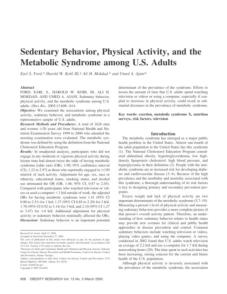

Author: Earl S. Ford
In recent years, major organizations have endorsed the
concept of metabolic syndrome and created working
definitions for it. This study aims to summarize the relative
risk estimates for all-cause mortality, cardiovascular disease,
and diabetes, as reported in prospective studies of general
population samples, using definitions of metabolic
syndrome developed by the National Cholesterol
Education Program (NCEP) and the World Health
Organization (WHO).
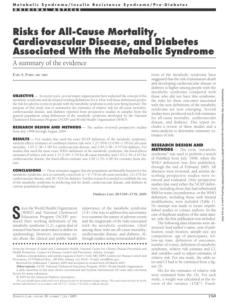

Authors:
Zeljko Dujic, Ivan Palada, Ante Obad, Darko Duplancic, Alf
O. Brubakk, and Zoran Valic
The study investigates whether intrapulmonary shunts,
which can cause neurological damage due to venous
gas emboli, occur after strenuous exercise following a
dive. Eleven healthy military divers performed a dive to 30
meters and mild exercise during the dive, followed by
more intense exercise 40 minutes after surfacing. The
results showed significant venous bubbles but no
intrapulmonary shunting or delayed-onset decompression
sickness. The authors suggest that short, strenuous
exercise after diving may be safe, but further research
with more participants is needed to confirm this.


Authors: JGeorg Kojda, Rainer Hambrecht
IRegular physical activity reduces cardiovascular disease
risk. Exercise promotes vascular remodeling, improving
blood flow. Physical forces activate mechanisms in cells
involving integrins and RhoA (regulating various cellular
processes). Exercise also enhances eNOS expression and
phosphorylation, providing vasoprotective effects. This
process is regulated by factors such as angiogenesis,
arteriogenesis, and antioxidative effects. As a conclusion,
exercise is an effective antioxidant and antiatherogenic
therapy.


Authors: Lars Lind, Nilla Fors, Jan Hall, Kerstin Marttala,
Anna Stenborg
This study evaluated the feasibility and usefulness of three
different techniques for assessing endothelium-dependent
vasodilation in the peripheral circulation within a large-
scale, elderly population-based setting. Conducted as part
of the Prospective Investigation of the Vasculature in
Uppsala Seniors (PIVUS) study, the findings revealed that
all three techniques were feasible for use in a general
elderly population.
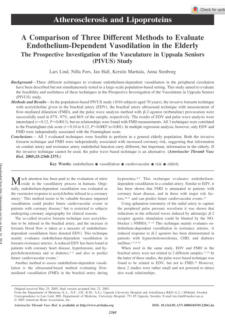

Authors:
James M. Antonini, Annette B. Santamaria, Neil T. Jenkins,
Elisa Albini, Roberto Lucchini
Occupational health officials are concerned about the
neurological effects of manganese in welding fumes. The
behavior of manganese in welding particles after
inhalation is unclear, and its various oxidation states and
solubility may affect biological responses. Therefore,
comprehensive epidemiological studies on welders'
exposure are needed.
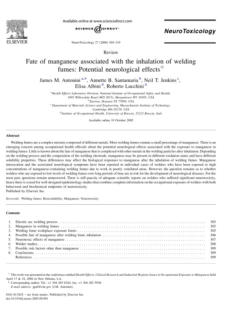

Authors:
Stephen R. Thom, Veena M. Bhopale, Omaida C.
Velazquez, Lee J. Goldstein, Lynne H. Thom, and Donald
G. Buerk
The study suggests that hyperbaric oxygen exposure
mobilizes stem cells through a nitric oxide mechanism. In
mice, HBO2 raised stem cell factor by 50% and increased
cells expressing stem cell markers. Bone marrow NO
concentration rose significantly with HBO2. NO synthase
inhibitors prevented stem cell mobilization in mice. Study
concludes that HBO2 stimulates NO synthesis to mobilize
stem cells.


Authors: H.D. Van Liew and E.T. Flynn
This document presents research findings on the risk of
decompression sickness (DCS) associated with direct
ascents from saturation dives in humans by analyzing
experimental data to identify a threshold depth at which
the risk of DCS increases significantly. It compares two
models for predicting DCS risk, highlighting that a model
incorporating a threshold provides more accurate
predictions than one without. The study also
recommends using the threshold model in specific
scenarios, such as submarine rescues and discusses the
implications for deeper dives where human data is
lacking.
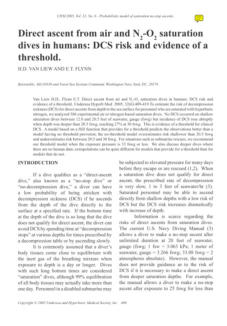

Authors:
John W. Castellani, Andrew J. Young, Michael N. Sawka
The authors of this paper present the findings of
experiments that investigated the effects of acute and
chronic exertional fatigue on thermoregulatory responses
during cold exposure. They explain the methodology,
results, and conclusions of these studies, highlighting how
prior physical exercise can influence heat loss and core
temperature decline when individuals are subsequently
exposed to cold conditions.
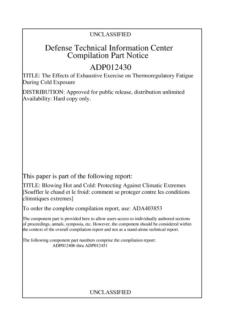



03 - Counterdiffusion Diving: Using Isobaric Mix Switching To
Reduce Decompression Time

Author: Glenn H. Taylor
Switching a diver’s breathing mix from heliox to nitrox at a
specified time during the bottom portion of the dive can
reduce the total stop time for long dives in the deep nitrox
range. Isobaric Mix Switching with oxygen decompression
reduced calculated total stop times by an average of 38%
compared to calculated total stop times using nitrox with
oxygen decompression. The optimal mix-switch time was
determined empirically using mixed-gas decompression
software.
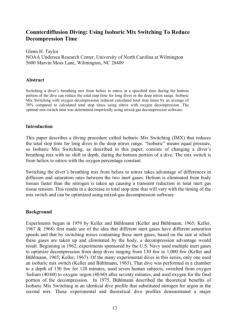



04 - The Risk of Decompression Sickness (DCS) is Influenced by Dive
Conditions
Author: Richard D. Vann, Petar J. Denoble, Donna M.
Uguccioni, Neal W. Pollock, , John J. Freiberger,
Carl F. Pieper, W.A. Gerth, and Robert Forbes
This report examined DCS risk in warm-water, cold-water,
and Navy dives, comparing predicted risks with actual
cases. Mean observed incidences were reported.
Predictions were adjusted. Conclusions include the
usefulness of probabilistic models for estimating risk and
noting that dive conditions also significantly impact risk.
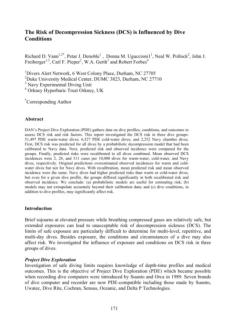

Authors: Carl Edmonds, Stephanie McInnes and Michael
Bennett
A workshop in 1999 found that some previous diving
rules to prevent decompression sickness (DCS) were
unnecessary under specific conditions. It suggested that
diving order, whether deep first or last, did not matter for
certain dives. The final recommendation allowed reverse
dive profiles (RDPs) for dives under 40 meters and with
depth differences under 12 meters.
According to the authors, this recommendation needs
careful evaluation as RDPs may be more dangerous than
forward dive profiles (FDPs). Current advice to use FDPs
should continue.

20 - Reverse dive profiles: the making of a myth

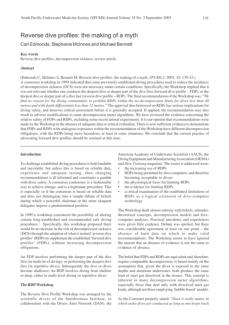

Author: Paul J Fenner
Jellyfish envenomation is far more common around the
world than is realised. Although the vast majority of
jellyfish stings are somewhat benign, there are some
venomous species that regularly account for both deaths
and severe morbidity in humans. Venomous jellyfish
occur mainly in tropical and subtropical oceans. This
article discusses relevant information on their appearance,
distribution, and symptoms of envenomation, and firstaid
and medical treatments for their stings.


21 - Venomous Jellyfish of the word
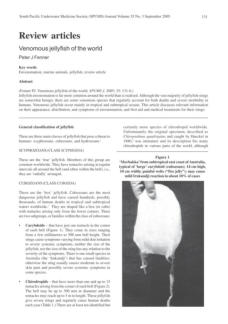




22 - The rate of decompression sickness in scientific diving at the
Australian Institute of Marine Science (Townsville) 1996 to 2001
Authors: Anthony Carter, Reinhold Muller and Angus
Thompson
This study discusses the rate of decompression sickness
(DCS) in scientific diving, following the Canadian Defence
and Civil Institute of Environmental Medicine (DCIEM)
decompression tables, and how the AS/NZS Scientific
Diving Standard (AS/NZS 2299. 2:2002) might affect dive
profiles at the Australian Institute of Marine Science (AIMS)
in Townsville. Data from October 1996 to December
2001 was collected, showing low DCS rates in multi-day
dives, and suggesting that AS/NZS limits may need
modification for scientific diving.
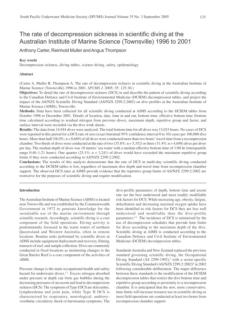



23 - The clinical incidence of central nervous system oxygen toxicity
at 284 kPa (2.8 ATA)
Authors: David Wilkinson, Sally Wright and Steven Goble
Central nervous system (CNS) oxygen toxicity is a known
issue with hyperbaric oxygen treatment (HBOT), often
leading to seizures. The frequency of this complication has
been reported differently. A review of data from the Royal
Adelaide Hospital from 1986 to 2003 found symptoms of
CNS oxygen toxicity and seizure occurrences in patients
treated at 284 kPa (2. 8 ATA). There is a higher seizure risk
in emergency treatments than in non-emergency ones,
particularly for female divers and during the initial
treatment for decompression sickness (DCS)
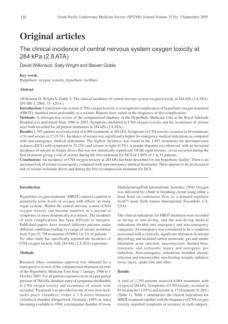



24 - The international safety record for scientific diving
Author: Martin Sayer
This study includes two papers reviewing the safety
records of scientific diving programs in Australia and the
United States. A previous review of a UK institution's diving
operations is also included. This commentary will compare
the safety trends of the three studies to evaluate the
relative risk levels in the scientific diving sector.
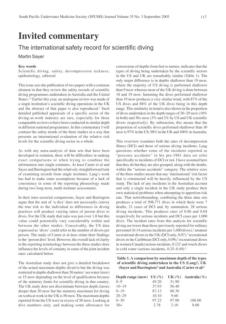


10 - World Health organization - Handbook for good clinical
research (GCP)

Author: World Health organization
Clinical research is crucial for establishing the safety and
effectiveness of health and medical products. Known
knowledge is based on randomized controlled trials,
which form the foundation for evidence-based
medicine. This handbook, based on WHO's guidelines
for Good Clinical Research Practice (GCP), assists national
regulatory authorities, sponsors, investigators, and ethics
committees in implementing GCP for industry-
sponsored, government-sponsored, institution-
sponsored, or investor-initiated clinical research.
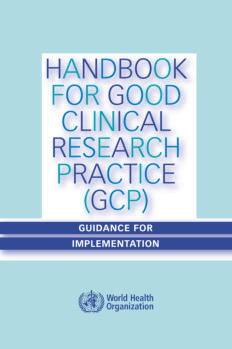



28 - Comparison between two methods for estimating
pneumothorax size from chest X-rays
Author: Anne-Maree Kelly, Daragh Weldon, Anna Y.L.
Tsang, Colin A. Graham
This study compared the Rhea inter-pleural distances
method and the CT-derived Collins method for
estimating the size of spontaneous pneumothoraces in
adult patients. 156 X-rays were taken from 57 patients,
with 82% being male and a median age of 22 years. The
Collins method estimated larger pneumothoraces, with
an average difference of 4%. The agreement was close
for small pneumothoraces but deteriorated with larger
sizes. The Rhea method is acceptable for smaller
pneumothoraces but may significantly underestimate
larger sizes.
